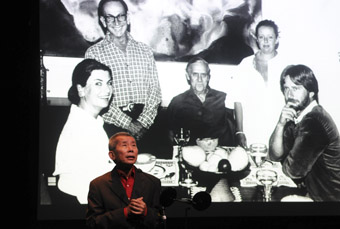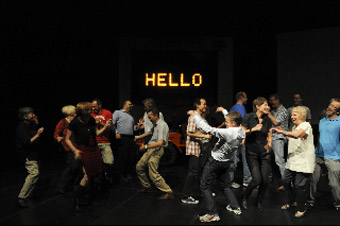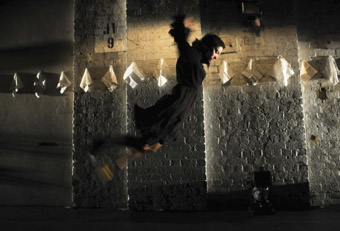person to persona
keith gallasch: sydney: william yang, rosie dennis, alexandra harrison

William Yang, My Generation
photo Heidrun Löhr
William Yang, My Generation
SOLO SHOWS BY WILLIAM YANG, ROSIE DENNIS, ALEXANDRA HARRISON AND MARTIN DEL AMO IN PERFORMANCE SPACE’S FIRST 2010 SEASON AND, SOON AFTER JOHN WATERS AND MIAOW MIAOW (SEE RT97) AT THE SYDNEY OPERA HOUSE, STIMULATED MY CASUAL THINKING ABOUT PRESENCE AND CHARISMA AND HOW TO DEFINE THE ENDURING APPEAL AND CRAFT OF PARTICULAR PERFORMERS—ESPECIALLY THOSE WHO ARE NOT ACTORS AND WHO ADDRESS US DIRECTLY, APPEARING TO BE PERFORMING THEIR OWN LIVES.
william yang
I’ve been watching William Yang’s performative slide shows since 1987. Now and then, one of them, like his latest, My Generation, leaps out as very special. This is partly because of its epic sweep, from the 70s—when Yang finds a place in the theatre firmament with Rex Cramphorn, Robyn Nevin, Jim Sharman, Kate Fitzpatrick)—through the 80s and 90s extending the photographer’s world to include the visual arts (Brett Whitely, Martin Sharpe), fashion (Jenny Kee, Linda Jackson, Flamingo Park) and the richly creative gay culture that overlapped and entwined with these through the likes of Peter Tully. And then there’s Patrick White, a daunting presence in My Generation but at his most apparently vulnerable in Yang’s exquisite portraits. And Tiny Tim. Over such a long period we witness artists and friends grow old or die, careers falter and friendships fail. Although Yang’s tone is light and, as ever, slightly detached if measuredly frank, the sense of mortality in tandem with hard-won survival is pervasive.
Yang’s performance persona across two decades has been remarkably stable. His confidence as a performer has certainly grown, but the basic ingredients, a coolish if affable, slow delivery, short carefully constructed sentences and physical fixity before a microphone all persist. The persona suggests someone who is possibly shy and requires a stable performative format—the rhythm of the slides might change but the spoken delivery varies little. Yang mentions in this performance that someone once described his photography as “not quite candid, a little bit formal.” It applies equally to his performance. Yes, the photographic work is candid, lined flesh and sweat are brightly lit everywhere, and there are the occasional surprises (a litter of post-party, naked bodies), but there are limits—Yang tells us about the photographs that got him into trouble (he is no paparazzi, the people he shoots are often his friends and this kind of work can put friendship at risk) if remaining unclear about how often he seeks permission to exhibit his images. His stage performance is likewise candid, but carefully constructed: like a novelist foreshadowing an incident, Yang will show a photograph, mention that he saw something in its subject that concerned him or was predictive, and quickly leave it. It’s a jolt, but inevitably he will come back to that person. Sometimes Yang’s comments seem unfair because you simply do not have enough information from him to understand what happened, and why, to a friend’s child who barely figures in the narrative—the thread in the weave is sometimes too thin. My Generation is also awash with personalities less well known, if at all, to newer generations, but remains valuable history if requiring clarification here and there.
My Generation is culturally rich with a strong sense of not just people but homes and events (for example, he says, when Mardi Gras used to be a cultural festival), meals shared, collaborations, openings and parties. A sense of privilege and furtiveness co-exist in the pleasure felt at seeing inside the homes of Patrick White and Margaret Fink and empathising with those who lose theirs. When Yang finds a home for himself and decides to live alone, he says it’s the closest to freedom he’s come. If candid about himself in previous works, perhaps Yang goes further in My Generation. As he and we watch other people’s children die or mature on the screen, Yang declares, “The pictures are like my children; they will tell my story when I am gone.” The William Yang performance persona hasn’t changed in any essential way over 20 years, but with each work we learn more about the man and his world. It’s rumoured that his body of work is destined for DVD, a welcome documentation of a life-in-progress, its milieu and the cultural life of Sydney, if likely viewed with the unease that perversely makes Yang’s work popular—that play between formal and candid, which one audience member described to me as passive-aggressive. Of course that might fit any number of people who use the camera as a tool for social engagement. [Sandy Edwards’ appreciation of My Generation is well worth reading at www.arthere.com.au/whatson/?p=92. Eds]

Rosie Dennis, DOWNTOWN
photo Heidrun Löhr
Rosie Dennis, DOWNTOWN
rosie dennis
My earliest memory of Rosie Dennis was of a barely audible voice emerging close by from the shadows in the old Performance Space as Eleanor Brickhill danced among us. These oddly complementary performances were, well, strangely primal, hard to nail down, even in those heady days of wilful opacity and theory-driven performance. Dennis’ amplified voice was distinctive—quiet but urgent, interrupted but oddly coherent, the words almost refusing to be given up. This seemed something more than performance poetry. When I later saw Dennis perform on her own, the surprise was even greater: the work was short, intense, un-miked, close-up, almost scary and sometimes funny as words and movement patterns locked into spasmodic loops, as if the performer was trapped in a moment of emotional recall from which there was no escape. The seemingly obsessive-compulsive drive yielded a memorable poetry and rough-hewn dancerliness that evoked a persona struggling to tell us something important if only the words would flow and voice and body come together.
These days, Dennis’ performances are more formal occasions—framed as a lecture or report, deploying props to illustrate the events in her anecdotalising or ideas in her scientific or metaphysical speculations. These loop back wryly into her stories with a Paul Auster-ish sense of the synchronistic interconnectedness of the cosmos. Perhaps she’ll dance, but wordlessly and privately. Perhaps she’ll sing, but with Sydney’s Gay and Lesbian Choir at the end of her latest performance, Downtown. The difference between early and current Dennis appears great—once I was alarmed by a ‘condition’ that shook up the notion of art, now I’m charmed by a presence that takes its all too willing audience (there’s a legion of fans) firmly in hand as confidante.
For Downtown, Dennis set herself the task of “walking and talking with strangers [in] inner suburbs of Sydney” and during a week-long residency at Performance Space reported daily on the construction of her performance which was then delivered complete on a Friday evening as “part process/part product.” Although the 44 people she approached (only three rejections) play a curiously small role in the performance, a funny email exchange with Yoko Ono looms large suggesting a personal ‘chemistry’ which is literalised in an onstage chemical experiment demonstrating “what we can do when we work together.” Downtown is a whimsical, even sentimental, work-in-progress from an artist who surprises us nowadays with subtleties and metaphysical turns but still fixes us as one with a searching eye and vocal rhythms that, although now comforting, still incline to the pulse of poetry, especially when Dennis is not striving to be poetic. While some performance personae stay pretty well fixed, others, like Dennis’, fascinatingly mutate and grow older, and stranger, with us.

Alexandra Harrison, Dark, Not Too Dark
photo Heidrun Löhr
Alexandra Harrison, Dark, Not Too Dark
alexandra harrison
In whatever work she appears, dancer and physical theatre performer Alexandra Harrison exudes a powerful presence. Here I’m seeing her for the first time as a solo performer, in a long dance work of her own making, Dark, Not Too Dark. In a RealTime-Performance Space Forum she described the work as “abstract”, the motivation for it explained in part in her program note where she writes, “My great grandfather wrote to Concetta, his Aeolian island bride, asking her to send him a photo. And when she did he took the picture of her by an empty chair…to a photographer and created another image, placing himself in the chair…her hand on his shoulder.” Another note defines remanence as “the residual magnetism left behind when the magnetising body no longer remains.” In Dark, Not Too Dark, Harrison appears to have absorbed the magnetism of her grandmother, resulting in a gothic channelling, unleashing pent-up gestures and dance movements.
As a voiceover intones the word “forever” over a growing hum and percussive glitching in Bob Scott’s musical score, Harrison, close to her audience, holds out her arms, palms down, sustaining the pose at great length until she begins to vibrate, the music deepening. She is entering another state of being. At last she lowers her arms, looks up and, in a series of moves, leans back, places a hand on her brow, and angles her whole body. The shape of it evokes a heroine locked in anguish in a 19th century melodrama or silent movie. The image of this transformation will recur across the work’s duration. In one of its most engaging passages, Harrison approaches an old gramophone horn which emits a strumming to which she responds with a burst of 20s-style dancing, raising her knees high, as if pulled in and out of the music and into the past as it grows louder. At times she looks like a novitiate, at times a mature woman or a creature caught in a tracking follow spot or endangered by a chandelier—she takes it away, smashes it, a new one, or the same one, descends. The word “forever” returns. As does Concetta, appearing eerily on the photographic studio backdrop.
Dark, Not Too Dark largely defies literal interpretation. The low light, repeated movements and strange images induce a kind of gothic delirium—a la Edward Gorey if without the laughs—but Harrison is, as always, fascinating to watch, driven, possessed, as if working through a very private madness, such is the work’s intensity, but to what end? A dark, but not too dark resurrection of the spirit of a forbear, an experiment that is both frightening and liberating? I’d like to experience the work again, a more economical version and with the sound score restrained (it’s emotionally over-inflated despite its many virtues). In Dark, Not Too Dark at its best, Alexandra Harrison envelops us in her vision creating an ambiguous persona, part grandmother, part herself.
My Generation, words, visuals William Yang, musician Daniel Holdworth, producer Performing Lines, Performance Space, Feb 23-March 6; Downtown, writer-performer Rosie Dennis, assistant Jacob Patterson, Sydney Gay & Lesbian Choir, Performance Space, March 5; Dark, Not Too Dark, creator-performer Alexandra Harrison, sound Bob Scott, design consultant Kate Davis, lighting Richard Manner, dramaturg Benedict Anderson; Performance Space, CarriageWorks, Feb 17-20
See Keith Gallasch’s critical appreciation of Tom Holloway’s new play Love Me Tender at Belvoir St.
RealTime issue #96 April-May 2010 pg. 36






